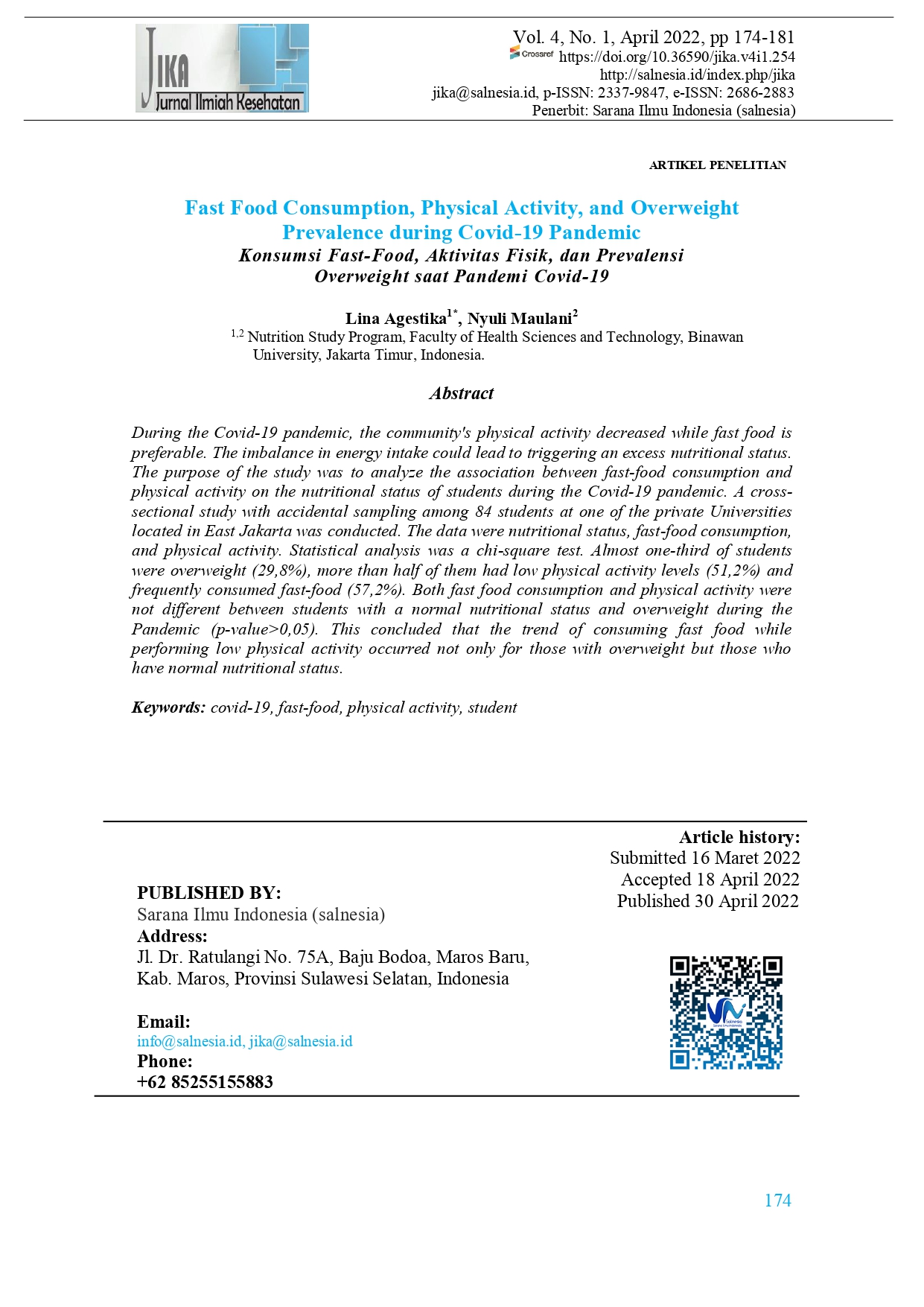Fast Food Consumption, Physical Activity, and Overweight Prevalence during Covid-19 Pandemic
DOI:
https://doi.org/10.36590/jika.v4i1.254Keywords:
covid-19, fast-food, physical activity, studentAbstract
During the Covid-19 pandemic, the community's physical activity decreased while fast food is preferable. The imbalance in energy intake could lead to triggering an excess nutritional status. The purpose of the study was to analyze the association between fast-food consumption and physical activity on the nutritional status of students during the Covid-19 pandemic. A cross-sectional study with accidental sampling among 84 students at one of the private Universities located in East Jakarta was conducted. The data were nutritional status, fast-food consumption, and physical activity. Statistical analysis was a chi-square test. Almost one-third of students were overweight (29,8%), more than half of them had low physical activity levels (51,2%) and frequently consumed fast-food (57,2%). Both fast food consumption and physical activity were not different between students with a normal nutritional status and overweight during the Pandemic (p-value>0,05). This concluded that the trend of consuming fast food while performing low physical activity occurred not only for those with overweight but those who have normal nutritional status.
Downloads
References
Adetunji AE, Adeniran KA, Olomu SC, Odike AI, Ewah-Odiase RO, Omoike IU, Akpede GO. 2019. Socio-demographic factors associated with overweight and obesity among primary school children in semi-urban areas of mid-western Nigeria. PLoS ONE, 14(4): 1–12. https://doi.org/10.1371/journal.pone.0214570.
Afrin S, Nasrullah SM, Dalal K, Tasnim Z, Md. Benzadid S. 2022. Mental health status of adolescents in-home quarantine: a multi-region, cross-sectional study during COVID-19 pandemic in Bangladesh. Afrin et al. BMC Psychology, 10:116. https://doi.org/10.1186/s40359-022-00819-3.
Ardella KB. 2020. Risiko Kesehatan Akibat Perubahan Pola Makan dan Tingkat Aktivitas Fisik Selama Pandemi COVID-19. Jurnal Medika Hutama, 2(01): 292-297.
Bahadoran Z, Mirmiran P, Azizi F. 2015. Fast food pattern and cardiometabolic disorders: a review of current studies. Health promotion perspectives, 5(4): 231.
Banik R, Naher S, Pervez S, Hossain MM. 2020. Fast food consumption and obesity among urban college going adolescents in Bangladesh: A cross-sectional study. Obesity Medicine. Elsevier, 17(September 2019): 100161. https://doi.org/10.1016/j.obmed.2019.100161.
Basic Health Research (Riskesdas). 2013. Ministry of Health (Indonesia): Jakarta.
Basic Health Research (Riskesdas). 2018. Ministry of Health (Indonesia): Jakarta.
Brooks JE, Moore DD. 2016. The Impact of Childhood Experiences on Perceptions of Health and Wellness in African American Young Adults. J Afr Am St, 20: 183-201. https://doi.org/10.1007/s12111-016-9327-3.
Ermona NDN, Wirjatmadi B. 2018. Hubungan Aktivitas Fisik dan Asupan Gizi dengan Status Gizi Lebih pada Anak Usia Sekolah Dasar di SDN Ketabang 1 Kota Surabaya Tahun 2017. Amerta Nutritio, 2(1): 97-105.
Huber BC, Steffen J, Schlichtiger J, Graupe T, Deuster E, Strouvelle VP, Martin RF, Steffen M, Stefan B. 2020. Alteration of physical activity during COVID-19 pandemic lockdown in young adults. Journal of Translational Medicine, 18(1):1-3.
Liberali R, Kupek E, Assis MAAD. 2020. Dietary patterns and childhood obesity risk: a systematic review. Childhood Obesity, 16(2): 70-85.
Manyanga T, El-Sayed H, Doku DT, Randall JR. 2014. The prevalence of underweight, overweight, obesity and associated risk factors among school-going adolescents in seven African countries. BMC Public Health, 14:887.
Mazidi M, Banach M, Kengne AP. 2018. Prevalence of childhood and adolescent overweight and obesity in Asian countries: A systematic review and meta-analysis. Archives of Medical Science. Termedia Publishing House Ltd, 14:1185–203.
Mohammadbeigi A, Asgarian A, Moshir E, Heidari H, Afrashteh S, Khazaei S, Ansari H. 2018. Fast food consumption and overweight/obesity prevalence in students and its association with general and abdominal obesity. Journal of Preventive Medicine and Hygiene, 59(3): E236–E240.
Muangmee C, Kot S, Meekaewkunchorn N, Kassakorn N, Khalid B. 2021. Factors determining the behavioral intention of using food delivery apps during covid-19 pandemics. Journal of Theoretical and Applied Electronic Commerce Research, 16(5): 1297–1310. https://doi.org/10.3390/jtaer16050073.
Nagata JM, Magid HAS, Gabriel KP. 2020. Screen time for children and adolescents during the coronavirus disease 2019 pandemic. Obesity, 28(9): 1582-1583.
Nur Annisa Resky, Haniarti, Usman. 2019. Hubungan Kebiasaan Konsumsi Makanan Cepat Saji Dan Asupan Energi Dengan Kejadian Obesitas Pada Mahasiswa Yang Tinggal Di Sekitar Universitas Muhammadiyah Parepare. Jurnal Ilmiah Manusia dan Kesehatan, 2(3): 322–332. https://doi.org/10.31850/makes.v2i3.153.
Oddo VM, Maehara M, Rah JH. 2019. Overweight in Indonesia: An observational study of trends and risk factors among adults and children. BMJ Open, 9(9).
Ruiz-Roso MB, de Carvalho Padilha P, Mantilla-Escalante DC, Ulloa N, Brun P, Acevedo-Correa D, Arantes Ferreira Peres W, Martorell M, Aires MT, de Oliveira Cardoso L, Carrasco-Marín F. 2020. Covid-19 confinement and changes of adolescent’s dietary trends in Italy, Spain, Chile, Colombia and Brazil. Nutrients, 12(6):1807.
Sukianto RE, Marjan AQ. 2020. Hubungan Tingkat Stres, Emotional Eating, Aktivitas Fisik, dan Persen Lemak Tubuh dengan Status Gizi Pegawai Universitas Pembangunan Nasional Jakarta. Ilmu Gizi Indonesia, 3(2): 113-122.
Stavridou A, Kapsali E, Panagouli E, Thirios A, Polychronis K, Bacopoulou F, et al. 2021. Obesity in children and adolescents during covid-19 pandemic. 2021(18).
Teshale D, Mesfin A, Gebremedhin S. 2019. Factors associated with overweight and obesity among adults in northeast Ethiopia: A cross?sectional study. BMC Obesity. BMC Obesity, 12: 391–399. https://doi.org/10.2147/DMSO.S179699.
Wang J, Zhu L, Liu L, Zhao XA, Zhang Z, Xue L, Yan X, Huang S, Li Y, Cheng, J, Zhang B. 2020. Overweight and obesity are risk factors of severe illness in patients with COVID?19. Obesity. 28(11): 2049-2055.
WHO. 2020a. Coronavirus Disease 2019 (COVID-19) Situation Report. WHO: Geneva
WHO. (2020b). Physical activity key facts. WHO: Geneva.
Yousif MM, Kaddam LA, Humeda HS. 2019. Correlation between physical activity, eating behavior and obesity among Sudanese medical students Sudan. BMC Nutrition. BMC Nutrition, 5(1): 1–8. https://doi.org/10.1186/s40795-019-0271-1.
Zukmadini AY, Karyadi B, Kasrina K. 2020. Edukasi Perilaku Hidup Bersih Dan Sehat (PHBS) dalam Pencegahan Covid-19 kepada Anak- Anak di Panti Asuhan. Jurnal Pengabdian Magister Pendidikan IPA, 3(1).

Downloads
Published
How to Cite
Issue
Section
License
Copyright (c) 2022 Lina Agestika, Nyuli Maulani

This work is licensed under a Creative Commons Attribution 4.0 International License.








